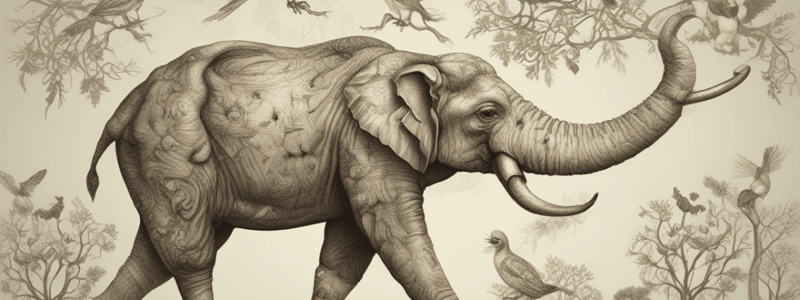Podcast
Questions and Answers
What is phylogeny?
What is phylogeny?
- The study of the structure of an organism
- The evolutionary history of an organism (correct)
- The analysis of DNA sequences of an organism
- The classification of an organism based on its morphology
What is the purpose of constructing phylogenetic trees?
What is the purpose of constructing phylogenetic trees?
- To determine the exact classification of an organism
- To show the evolutionary relationships between different groups of organisms (correct)
- To show the morphological similarities between organisms
- To study the behavior of different species
What does a branch point in a phylogenetic tree represent?
What does a branch point in a phylogenetic tree represent?
- A group of organisms that are closely related
- A group of organisms that share a common characteristic
- The last common ancestor of two or more organisms (correct)
- A group of organisms that are not closely related
What are homologous structures?
What are homologous structures?
What are analogous structures?
What are analogous structures?
Why is morphology no longer the sole basis for classification?
Why is morphology no longer the sole basis for classification?
What is a vestigial structure?
What is a vestigial structure?
What is the primary function of a molecular clock in evolutionary biology?
What is the primary function of a molecular clock in evolutionary biology?
What is the term for the study of the morphology of ancient species?
What is the term for the study of the morphology of ancient species?
What do scientists use to group organisms into categories that represent lines of evolutionary descent?
What do scientists use to group organisms into categories that represent lines of evolutionary descent?
What is an example of a vestigial structure in humans?
What is an example of a vestigial structure in humans?
What is the primary purpose of comparing the DNA sequences of two species?
What is the primary purpose of comparing the DNA sequences of two species?
What is the term for the study of the development of embryos?
What is the term for the study of the development of embryos?
What is the significance of the presence of an amnion in embryonic development?
What is the significance of the presence of an amnion in embryonic development?
What is the primary purpose of comparing the proteins of two organisms?
What is the primary purpose of comparing the proteins of two organisms?
What is the term for the similarities in chemical compounds found within cells?
What is the term for the similarities in chemical compounds found within cells?
Which of the following types of evidence is used to determine the evolutionary relationships between organisms?
Which of the following types of evidence is used to determine the evolutionary relationships between organisms?
What is the significance of finding similar genes in two organisms that are anatomically very different?
What is the significance of finding similar genes in two organisms that are anatomically very different?
What is the purpose of comparing the DNA sequences of two species?
What is the purpose of comparing the DNA sequences of two species?
What is the significance of finding similar embryological structures in two organisms?
What is the significance of finding similar embryological structures in two organisms?
What is the primary reason modern taxonomists consider phylogeny when attempting to classify an organism?
What is the primary reason modern taxonomists consider phylogeny when attempting to classify an organism?
What is the main difference between homologous and analogous structures?
What is the main difference between homologous and analogous structures?
What is the significance of the wing of a bird, the wing of a bat, the forearm of a human, and the flipper of a whale being homologous structures?
What is the significance of the wing of a bird, the wing of a bat, the forearm of a human, and the flipper of a whale being homologous structures?
Why is morphology no longer sufficient for classification?
Why is morphology no longer sufficient for classification?
What is the primary advantage of using phylogenetic trees in classification?
What is the primary advantage of using phylogenetic trees in classification?
Flashcards are hidden until you start studying
Study Notes
Modern Taxonomy
- Modern taxonomists consider phylogeny, the evolutionary history of an organism, when attempting to classify it.
- Phylogenetic trees show the evolutionary relationships between different groups of organisms.
- The common ancestor of all organisms on a phylogenetic tree is represented by a branch point.
Phylogenetic Trees
- The phylogenetic tree shows the evolutionary relationships between different groups of organisms.
- Example: The phylogenetic tree of the Animal Kingdom shows the relationships between phyla.
Traditional Taxonomy
- Morphology, or the structure of the organism, was the basis for classification.
- Linnaeus' system of classification was based on morphology.
Morphology
- Morphology is classification based on the structures possessed by the organism.
- Homologous structures are similar in different species due to common ancestry.
- Example: The bones found in the wing of a bird, the wing of a bat, the forearm of a human, and the flipper of a whale are homologous.
- Analogous structures are similar in function but not in structure and are not derived from a common ancestor.
- Example: The wing of a bird and the wing of a butterfly have the same function but different structures.
- Vestigial structures are reduced in size and seem to be "left over" from a previous ancestor.
- Example: The appendix.
Additional Lines of Evidence
- The fossil record provides clues about the morphology of ancient species but is an incomplete record.
- Other lines of evidence must be considered when classifying an organism.
Cellular Organization
- Similarity in cell structures provides evidence of relationships between organisms.
- Examples: Types of plastids present, presence of a nucleus, cell wall composition.
Evolutionary Relationships
- Scientists group organisms into categories that represent lines of evolutionary descent or phylogeny.
- Fossils show that organisms alive today are similar to extinct organisms.
- Example: 25 breeds of dogs came from a wolf-like ancestor.
Biochemical Similarities
- Similarities of chemical compounds found within cells can be used as evidence to show relationships between organisms.
- A comparison between the proteins of two organisms serves as a "molecular clock".
- Example: The number of differences in amino acid sequences in proteins can indicate how long ago two species diverged from a common ancestor.
Genetic Similarities
- Similarities in DNA sequences and chromosome number can indicate relationships between organisms.
- Example: Humans and yeasts have similar genes for building myosin protein.
- The more similar the DNA sequences of two species, the more recently they shared a common ancestor.
Embryological Similarities
- Similarities in embryological development provide evidence of phylogenetic relationships.
- Example: The presence of an amnion in the embryos of reptiles, birds, and mammals indicates a common ancestry.
- The more similar the embryological development of two species, the more closely they are related.
Modern Taxonomy
- Modern taxonomists consider phylogeny, the evolutionary history of an organism, when attempting to classify it.
- Phylogenetic trees show the evolutionary relationships between different groups of organisms.
- The common ancestor of all organisms on a phylogenetic tree is represented by a branch point.
Phylogenetic Trees
- The phylogenetic tree shows the evolutionary relationships between different groups of organisms.
- Example: The phylogenetic tree of the Animal Kingdom shows the relationships between phyla.
Traditional Taxonomy
- Morphology, or the structure of the organism, was the basis for classification.
- Linnaeus' system of classification was based on morphology.
Morphology
- Morphology is classification based on the structures possessed by the organism.
- Homologous structures are similar in different species due to common ancestry.
- Example: The bones found in the wing of a bird, the wing of a bat, the forearm of a human, and the flipper of a whale are homologous.
- Analogous structures are similar in function but not in structure and are not derived from a common ancestor.
- Example: The wing of a bird and the wing of a butterfly have the same function but different structures.
- Vestigial structures are reduced in size and seem to be "left over" from a previous ancestor.
- Example: The appendix.
Additional Lines of Evidence
- The fossil record provides clues about the morphology of ancient species but is an incomplete record.
- Other lines of evidence must be considered when classifying an organism.
Cellular Organization
- Similarity in cell structures provides evidence of relationships between organisms.
- Examples: Types of plastids present, presence of a nucleus, cell wall composition.
Evolutionary Relationships
- Scientists group organisms into categories that represent lines of evolutionary descent or phylogeny.
- Fossils show that organisms alive today are similar to extinct organisms.
- Example: 25 breeds of dogs came from a wolf-like ancestor.
Biochemical Similarities
- Similarities of chemical compounds found within cells can be used as evidence to show relationships between organisms.
- A comparison between the proteins of two organisms serves as a "molecular clock".
- Example: The number of differences in amino acid sequences in proteins can indicate how long ago two species diverged from a common ancestor.
Genetic Similarities
- Similarities in DNA sequences and chromosome number can indicate relationships between organisms.
- Example: Humans and yeasts have similar genes for building myosin protein.
- The more similar the DNA sequences of two species, the more recently they shared a common ancestor.
Embryological Similarities
- Similarities in embryological development provide evidence of phylogenetic relationships.
- Example: The presence of an amnion in the embryos of reptiles, birds, and mammals indicates a common ancestry.
- The more similar the embryological development of two species, the more closely they are related.
Studying That Suits You
Use AI to generate personalized quizzes and flashcards to suit your learning preferences.




